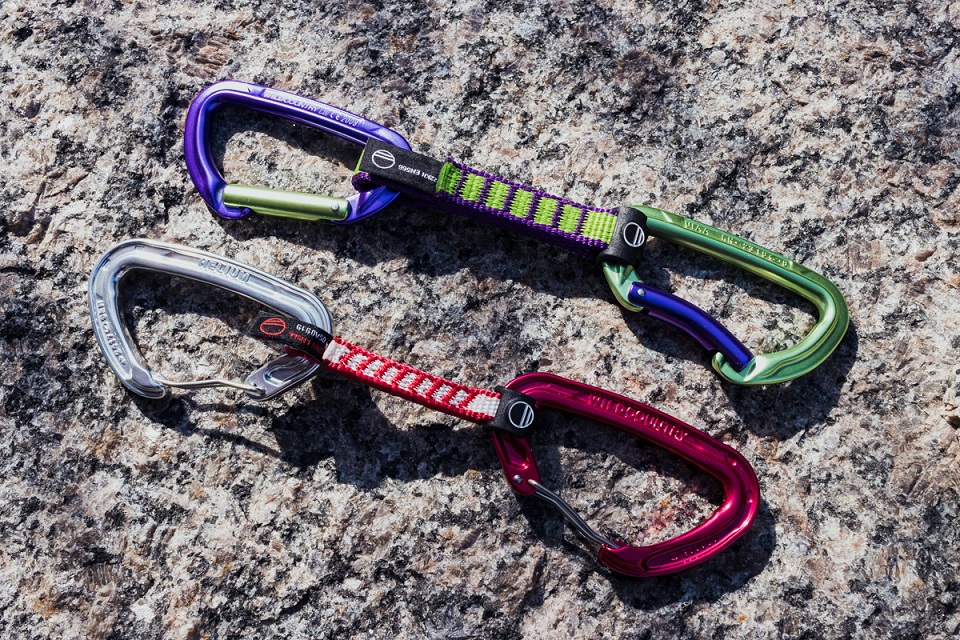Hanging from the side of nature's beautifully sculpted peaks, experiencing a shot of serene and adrenaline, sport climbing gives you the ultimate opportunity to taste what flying feels like without using wings or machines. So folks, what is sport climbing, and what necessary gear is required for this type of climbing adventure? I have compiled this informative article to run you through the ins and outs of sport climbing.
What Is Sport Climbing? (The Basics Of Getting Started)
Sport climbing is an art of rock climbing with the help of permanent pitons and anchors drilled in the crag or rock face. The climbers attach to these anchors by using quickdraws that consist of two carabiners connected with the help of a fabric sling or dogbone. Quickdraws are essential gear equipment for belaying and safety purposes. The sport climbers can climb multi-pitch climbs or a single route with the aid of a rope and a belayer.
Sport climbing requires absolute focus, complete immersion, and a high level of enjoyment to sense a nearly transcendental experience. The climbers transfer their body weight between each anchor point fluently to increase efficiency and create momentum. Legs are used to ascend upward and minimize the force of gravity, while arms and hands are used to position and balance the body.
Personally, sports climbing gives me a whole new perspective of what I am doing. It immerses me in the landscape. I am fully present on the rock with all my senses alert, paying close attention to the details around me, the features of the rock and the sound.
For More Inspiration - Best Climbing Movies

How Does Sport Climbing Work?
The process of climbing is quite simple. Sport climbing is done solo, in a pair, or group. The lead climber who carries the climbing rope is the first person to ascend the rock face. When he reaches an anchor spot, he clips in with a quickdraw that protects if the lead climber or his partner falls off the rock face. The climber continues upward until the next piton, where he clips in. At this point, the belayer or second climber unclips from the lower piton and keeps ascending.
If you are pursuing solo sport climbing, you will be clipped into multiple pitons with a long rope to keep you ascending. Sport climbing can be single pitched when ascending and descending one crag. In multi-pitch sport climbing the lead climber continues to climb until he reaches the end of one pitch. The lead climber then top belays his partner so that he can reach the end of this pitch. At this point, they can switch roles between second climbing and lead climbing for their next pitch.
Related Article - How To Start Rock Climbing For Beginners
Key Considerations For Sport Climbing
Even if you have practiced a lot of sports climbing in the gym or indoors for beginners, I recommend single pitch climbing in pairs to be on the safe side. They must also learn to trust their partner and be there for their partner to help.
If you want to make your sports climbing experience enjoyable and safe, I advise you to refine your rappelling and climbing at the gym. Build your strength to climb near-linear rock faces while keeping your momentum and balance.
Don't forget to research your route before heading out. It would be wise to befriend members of the climbing community and consult graphical maps, climbing blogs, and guide books to learn about climbing strategies and routes.
Climbers need to pack essential gear for each pitch, such as harness, carabiners, rope, chalk, and many more. Apart from these critical equipment types, the sport climbing gear also includes suitable clothing and footwear that can make the pursuit comfortable.
Essential Sport Climbing Gear
What are you packing for your first sports climbing rack? Unlike other outdoor activities, I think sports climbing gear is very basic and straightforward. Here I have listed some of the most crucial sport climbing gear items required for a safe and memorable climbing adventure.
Sport Climbing Rope
One of the most obvious and important pieces of sports climbing gear is the sports climbing ropes. Ropes are used in tandem with proper use of other gear essentials such as cams, quickdraws, belay devices, carabiners, and your harness to save your life if you fall or slip from the rock face.
Let me be very honest, even if you own a perfect quality climbing rope, you need to learn how it functions and how you have to work with the associated apparatus. Once you become an experienced climber, now you can buy your rope but you have to consider the following factors:
Factors vary depending upon the route you select to climb. From my personal experience, it is also worth knowing that too much rope can lead to rope drag on the wall, so only carry an optimum length of rope required for the route you have selected. If you take extra rope, you will be surprised how heavy it will feel when you get exhausted.

Sport Climbing Harness
Now that you have bought a climbing rope you need to invest in a harness to attach to it. No matter what type of climbing you intend to do, your focus should be on your comfort and safety while buying a harness. I recommend you keep the following factors in mind when looking for the best sports climbing harness:
Don't forget to examine the harness for damage or defect even if you buy a new one. Not long ago, hundreds of faulty harnesses were seized from a seller on eBay. Therefore a little examination will go a long way.

Sport Climbing Shoes
Stepping on a rock face without proper shoes is not heard of. This means there is no rock climbing without appropriate shoes. Earlier climbers used mountaineering boots for climbing but now tight-fitting, lightweight rubber shoes similar to ballet slippers are used. This design allows the climber stores to jam into small gaps and find a better hold and grip on the rock.
When you search the market for sport climbing shoes, you will come across a variety of rubber shoes that are stickier and softer than others. Personally, I recommend rubber shoes that provide better support and edging for your foot. If you are looking for shoes for a better grip for smearing on slabs, your rubber shoes are a good choice but they are less durable and they don't stand up long enough to the abrasion.

Sport Climbing Quickdraws
As we know that sports climbing routes are protected by a line of bolts and anchors drilled into the rock, so climbers need quickdraws to cover a route. Quickdraws are two carabiners that are linked with each other with a fabric. You will come across two versions of quickdraws the short and the long ones. Short draws are 10 to 12 cm in length and are lighter on your harness, making them a perfect option for the straight route. Long draws are 15 to 18 cm in length and are good for long meandering routes are cliffs as they help reduce rope drag.
In my opinion, you need to pack a mixture of these two lengths so that it gives you options depending upon the situation that comes during your climb. For me, an average of 12 to 16 draws are enough for a variety of crags. However, your best choice is short and lightweight draws with a wide sling for easy handling.

Sport Climbing Clothing
Many climbers don't realize that a good selection of clothing is as important as shoes, harnesses, and the rest of the sports climbing essentials.
In your approach to sports, climbing don’t forget to check the weather. Figure out how cloudy, sunny, or hot weather will be and pack accordingly. I suggest you stick to spandex material as it is a great option to control moisture and offers flexibility.
For your upper body tank top is a good choice for women and for men, tees are fine. Instead of going for pants and shorts, it would be best to choose a three-quarter length pant or capris that allows protection and easy movement.
Sport Climbing Vs Lead Climbing
Lead limbing is a set skill that is a part of both trad climbing and sport climbing. It is the process or method with which you get the rope attached to you on the ground to your chosen climb or an anchor. Lead climbing comes in handy if a climber cannot access the route from above or he doesn't want to go climbing without ropes. In this case, climbers will form a party and one person will lead the climb and he sets the top rope.
In contrast, sports climbing routes are protected by pre-placed anchors. One of the most important differences between lead climbing and sport climbing is that lead climb is not possible without a partner to belay you. In this case, belayers also need to be able to lead belay. In lead belaying, the belayer feeds rope out to the lead climber during ascending. In contrast, in top ropping, the belayer takes up the rope as they ascend.
Sport Climbing Vs Trad Climbing
Trad is short of traditional climbing commonly called plain old climbing, which is different from sports climbing in many ways.
In trad climbing the climbers use their brain and utilize technical climbing skills, whereas sports climbing is all about strength and muscle building.
The climber also needs to pack more additional gear for trad climbing, such as chalk and cams placed strategically along the route where they are climbing. In contrast, sport climbing doesn't require much plan or strategy as the climber climbs along a pitch or route that has prereplaced bolts and anchors ready for him.
Trad climbing is always done outdoors, so be mindful of the sunset and sunrise as you need to start early to finish in time. Generally, sports climbing is much safer than trad climbing.
Frequently Asked Sport Climbing Questions
Is sport climbing dangerous?
Sports climbing is one of the safest options among other climbing types because of permanent drilled anchors on the rock face. However, over the years, there have been many accidents resulting in injuries that can even be fatal. As long as safety precautions are taken, it is no less or more than any other similar activity.
Does sport climbing make you stronger?
Yes, sports climbing pushes your strength to the limit. It is a great combination of strength and cardio training making it a total body workout. It increases the overall flexibility and tone of your muscles. Regular sports climbing can improve endurance and stamina. Also, all the stretching and reaching for holds greatly improves your muscles' agility, flexibility, and tone.
What is top roping?
In top-roping, the rope is anchored at the top of the route with two functional ends. One end is with the belayer, and the other is with the lead climber.
What is free climbing?
It is a form of rock climbing mostly practiced by climbers. The climbers don't use artificial help to gain height and only rely on their physical abilities. The necessary equipment and rope are only used to protect him from falling, which means that gear is not used to progress upwards. Don't confuse free climbing with soloing, as they both are different.
Conclusion
Rock climbing is one of the most adventurous and exhilarating sports activity around the globe. To make the most out of it, you need to learn it from an experienced instructor, research your route carefully, refine your skills indoors, and get equipped with the essentials to enjoy this activity. You should be physically strong enough and all your focus should be on what you are doing to increase your efficiency and preserve your momentum.
If you feel the urge to scale a rock face, don't hesitate, take the precautionary measures and get started.
